Abstract
In this study, we show the repetitive detection of toluene on a tapered optical fiber element (OFE) with an attached layer of Pseudomonas putida TVA8 bioluminescent bioreporters. The bioluminescent cell layer was attached on polished quartz modified with (3-aminopropyl)triethoxysilane (APTES). The repeatability of the preparation of the optical probe and its use was demonstrated with five differently shaped OFEs. The intensity of measured bioluminescence was minimally influenced by the OFE shape, possessing transmittances between 1.41% and 5.00%. OFE probes layered with P. putida TVA8 were used to monitor liquid toluene over a two-week period. It was demonstrated that OFE probes layered with positively induced P. putida TVA8 bioreporters were reliable detectors of toluene. A toluene concentration of 26.5 mg/L was detected after <30 min after immersion of the probe in the toluene solution. Additional experiments also immobilized constitutively bioluminescent cells of E. coli 652T7, on OFEs with polyethyleneimine (PEI). These OFEs were repetitively induced with Lauria-Bertani (LB) nutrient medium. Bioluminescence appeared 15 minutes after immersion of the OFE in LB. A change in pH from 7 to 6 resulted in a decrease in bioluminescence that was not restored following additional nutrient inductions at pH 7. The E. coli 652T7 OFE probe was therefore sensitive to negative influences but could not be repetitively used.
1. Introduction
Primarily controlled chemicals identified in regulations (i.e., United Nations Environment Programme) are selected due to their toxicity in low concentrations, bioaccumulation potential, persistency, carcinogenicity, and repeated assessment in monitoring programs [1,2]. Due to the widespread use of petroleum products and their chemical properties, the most common and stressed water pollutants are benzene, toluene, ethylbenzene and the xylene isomers (BTEX) [3]. It has been shown that these chemicals have adverse health effects, specifically leukemia, cancer, plastic anemia, or bone-marrow disorders in humans, even at low doses [4,5,6]. Solid-phase microextraction techniques and stir-bar sorptive extraction in combination with chromatographic and mass spectrometric analysis have been widely accepted for the analysis of various water pollutants [7,8].
Bioluminescent bioreporters producing light as a response to the presence of specific pollution, such as organic compounds or metals, have been constructed since 1992 [9]. The development and application of whole cell bioreporters has shown great promise in the laboratory and under controlled conditions [10,11,12]. In recent years, smartphones [13] and drones [7] have been used as whole cell biosensor devices with bioluminescent bioreporters. Regardless of many assays, case studies, and constructions of unique biosensor devices such as bioluminescent bioreporter integrated circuits (BBICs) [8], there is no company or institution that has yet established the commercial utilization of bioluminescent bioreporters for the evaluation of pollutant bioavailability. Chemical analysis based on gas chromatography and mass spectroscopy (GC/MS) remains the preferred method, although its combination with bioluminescent bioreporters might reduce the cost and increase the speed of identifying polluted sites, interpreting the hazard of pollutants, and predicting suitability for biodegradation as well as monitoring of biodegradation. A main reason for the limited use of bioluminescent bioreporters is legislative regulation against the environmental release of genetically manipulated cells, e.g., [14]. To better establish the potential utility of bioluminescent bioreporters and their complementary optical biosensor devices, more empirical evidence of field applications and studies of reproducibility and stability, as well as facilitation of analytical protocols and biosensor constructions, are needed.
Continuous monitoring with whole cell biosensors requires repeated inoculation [7] or immobilization [15] of cells on the sensing element. In comparison with other immobilization techniques, the immobilization of bioluminescent bioreporters by attachment on a surface of the sensing element has two advantages: the formation of a layer of cells attached to a surface does not involve any dropping or printing machines, and the cells adhere tightly to the sensing element to minimize loss of the detected bioluminescence signal.
Reporter cells immobilized on the tip of an optical fiber can enable continuous measurements in small volume samples and remote localities. The tiny dimensions of an optical fiber (diameter of fiber end <600 µm) make it possible to immobilize only a few cells on the fiber tip. However, such a small number of cells provides a low light intensity, resulting in low biosensor sensitivity. To increase the signal intensity, the light coupling efficiency can be increased by etching the fiber tip and increasing the number of adhered reporter cells by encapsulation into alginate beads [16]. An increase in bioluminescence signal intensity has also been achieved by the immobilization of reporter cells on the wider end (Ø 1 mm–1 cm) of a tapered optical fiber element [17,18].
In our previous research [19], we demonstrated bioluminescent monitoring of toluene over a period of 135 days by adherence of P. putida TVA8 to the chemically modified wider end of a tapered optical fiber element (OFE). This study aims to further elucidate the characteristics of such an OFE-type biosensor. Five different OFEs and two bacterial bioluminescent bioreporter strains were examined. Apart from P. putida TVA8, whose bioluminescence is positively induced by toluene [20,21], we also immobilized Escherichia coli 652T7, whose bioluminescence is constitutive and decreases in the presence of biotoxicants or other factors that affect cell viability [22]. The bioluminescence of cell layers of P. putida TVA8, adhered to several types of OFEs, were induced daily with toluene. Similarly, adhered cell layers of E. coli 652T7 were exposed to Luria-Bertani (LB) nutritional media for two weeks. Transmission profiles of all OFEs were calculated with a software script [17] and the results were compared to measured light intensities.
2. Materials and Methods
2.1. Materials and Solutions
All chemicals used were purchased from Fisher Scientific. Piranha solution contained concentrated H2SO4 and 30% H2O2 in a volume ratio of 7:3. LB medium contained tryptone (10 g), yeast extract (5 g) and NaCl (10 g) dissolved in 1 L of distilled water. For solid medium, 17 g of agar was added. Selective LB medium was supplemented with kanamycin (LBkan) at a final concentration of 50 mg/L. Phosphate buffer (PB) contained Na2HPO4·12H20 (23.637 g) and KH2PO4 (8.98 g) in 1 L of distilled water. The trace element solution contained H3BO3 (0.062 g) in 1 L of 1M HCl, than CaCl2 (2.94 g), ZnSO4·7H2O (1.44 g), CuSO4·5H2O (0.39 g), Na2MoO4·2H2O (0.53 g), MnSO4·H2O (3.5 g), and FeCl3·6H2O (5.4 g/L) was added in 1 L of distilled water. The mineral salt medium (MSM) consisted of MgSO4·7H2O (0.2 g), NH4NO3 (0.2 g), trace element solution (0.1 mL), ferric chloride solution (0.1 mL), PB (100 mL) and distilled water (900 mL). The yeast minimal medium (YMM) consisted of yeast nitrogen base without amino acids (6.7 g/L), synthetic drop-out supplement Y1774 (1.46 g/L), and glucose to the final concentration of 2% (w/v). For solid medium, 20 g of agar was added.
The toluene induction solution consisted of MSM (19 mL) and toluene-saturated water (1 mL). The final concentration of toluene was 26.5 mg/L, pH 7.2.
The LB induction solution contained 75% of MSM and 25% of LB medium.
The LB, PB and MSM media were autoclaved at 121 °C for 40 min. The trace elements, ferric chloride, and glucose solutions were sterilized by filtration through polytetrafluoroethylene Nalge Nunc Syringe Filters, 0.2 μm from Fischersci.com (Pittsburgh, PA, USA). The YMM was autoclaved at 121 °C for 20 min and was supplemented with sterile glucose to achieve final 2% concentration.
2.2. Microorganisms and Their Cultivation
Bioluminescent bioreporter microorganisms were kindly provided by the University of Tennessee. Pseudomonas putida TVA8 is a bioluminescent bioreporter harboring a chromosomal tod-luxCDABE fusion [23] and produces bioluminescence in the presence of BTEX (benzene, toluene, ethylbenzene and xylene) and trichlorethylene. The constitutively bioluminescent bacterium Escherichia coli 652T7 is a luxCDABE-based strain that was used by Du et al. (2015) to monitor the biotoxicity of cellulose nanocrystals [22].
P. putida TVA8 and E. coli 652T7 cells were separately cultivated on LBkan agar for 48 h at 28 °C and then reinoculated to LBkan broth. The cultures were placed in a shaking incubator at 100 rpm and 28 °C and grown overnight to an optical density at 600 nm (OD600) of 0.3 ± 0.15 [18,22].
2.3. Tapered Optical Fiber Elements (OFEs)
An OFE manufacturing starts with a preform which is heated in a furnace and drawn into an optical fiber. The narrowing part between the dripped part and the fiber was used as an OFE (Figure S1). The resulting shape is determined by preform size, drawing temperature and weight. The OFEs were kindly donated from the Institute of Photonics and Electronics of the Czech Academy of Sciences. The ends of OFEs were polished. Each OFE was characterized by diameters (Dx) measured in 10 mm distances along its length (L = Zmax) (Figure 1 and Figure 2). For the purpose of software calculations (transmittance), the OFE shapes were approximated by a bi-exponential equation (“Exp2”) in Matlab software (Table 1). This software was used by Kalabova et al. (2018) [17] to compare the model simulations to the real bioluminescence measured with OFEs.

Figure 1.
Diagrammatic representation of a tapered optical fiber element (OFE).
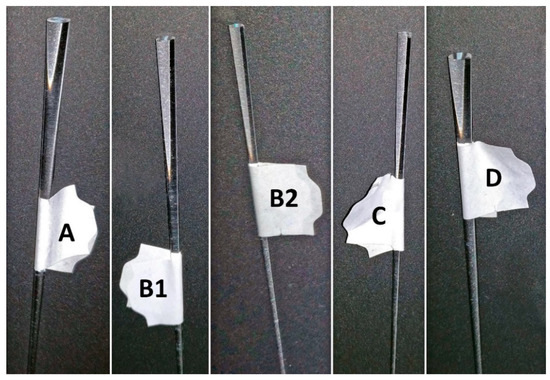
Figure 2.
Photographs displaying the wider ends of the OFEs used in this study.

Table 1.
Designation of OFEs used in this study. OFEs were approximated using the bi-exponential equation y = y0 + A1*exp(-x/t1) + A2*exp(-x/t2). OFE diameters (Length, Dmax, Dmin) and equation parameters (A1, t1, A2, t2, y0 = 0) are listed.
2.3.1. Preparation of OFEs for Chemical Modification
The OFEs were washed in acetone and rinsed with deionized water. The wider end of the OFE was immersed in Piranha solution at 70 °C for 30 min, washed again in deionized water, and dried at 110 °C for 1 h. After drying, the wider ends of the OFEs were modified with (3-aminopropyl)triethoxysilane (APTES) or polyethyleneimine (PEI).
2.3.2. Surface Modification of OFE with APTES
The wider end of each OFE was immersed in a solution of 5% (v/v) APTES in dry toluene at ambient temperature for 24 h. Afterwards, the OFE was rinsed with toluene and acetone and finally dried at 110 °C for 1 h (modified protocol from [24]).
2.3.3. Surface Modification of OFE with PEI
The wider end of the OFE was immersed in a 0.2% (w/v) solution of PEI in deionized water for 30 min and then air-dried [25].
2.4. Adsorption of Bioreporter Cells on OFE Modified Surfaces
The APTES-modified end of the OFE was fixed vertically in an Erlenmeyer flask containing 150 mL of LBkan medium to which was added 1 mL of an overnight culture of either P. putida TVA8 or E. coli 652T7. Cells grew and adsorbed on the wider element end in a shaker at 50 rpm and 28 °C for 4 days (i.e., the minimal time needed for P. putida TVA8 cells to be adsorbed [19]).
To increase adsorption of E. coli 652T7 to the APTES modified OFE surface, FeCl3 was added to the LBkan growth medium at a final concentration of 150 µM [26].
Due to inadequate growth of E. coli 652T7 on the APTES modified OFE surface, the PEI modified surface was attempted as an alternative. A 20 mL aliquot of an overnight culture of E. coli 652T7 in LBkan medium was centrifuged at 3000 g for 5 min. The pellet was resuspended in 20 mL MSM and centrifuged again at 3000 g for 5 min. The pellet was then resuspended in 20 mL of 0.2% PEI in MSM and left in a shaker for 30 min at 100 rpm and 28 °C. Finally, the culture was centrifuged at 3000 g for 5 min and the pellet resuspended in 20 mL of MSM [25]. The wider end of the PEI modified OFE was then immersed in the 20 mL suspension of E. coli 652T7 and shaken at 50 rpm for 30 min and 28 °C.
2.5. Measurement of Induced Bioluminescence
The thin end of the OFE was attached to a light guiding cable, which was connected to the Oriel 70680 photon multiplier tube. The accelerating voltage of the photon multiplier tube was set to 850 V and the electrical current was manually read from the Oriel 7070 detection system. Experiments were set-up and performed in a light-tight box. The wider end of the OFE with the adsorbed cells was fixed 4 ± 1 mm from the bottom of a 50 mL glass beaker that was then filled with 10 mL of induction solution (toluene for P. putida TVA8 or LB/MSM for E. coli 652T7), thereby immersing the wider end of the OFE in the induction solution (Figure 3). Reflective aluminum foil was placed underneath the beaker. The current, proportional to the intensity of bioluminescence, was recorded every 30–60 min for 18 h at an ambient temperature of 21 °C. Every 24 h, the wider end of the OFE was gently washed with MSM using a pipette, and then re-immersed into fresh induction solution. Exceptions to these 24 h washings were the 1–3 day pauses for holidays and weekends. On these days, the element remained immersed in the induction solution for up to 72 h. Five different OFEs were tested (Figure 2) with each one being measured over a period of 14–20 days.
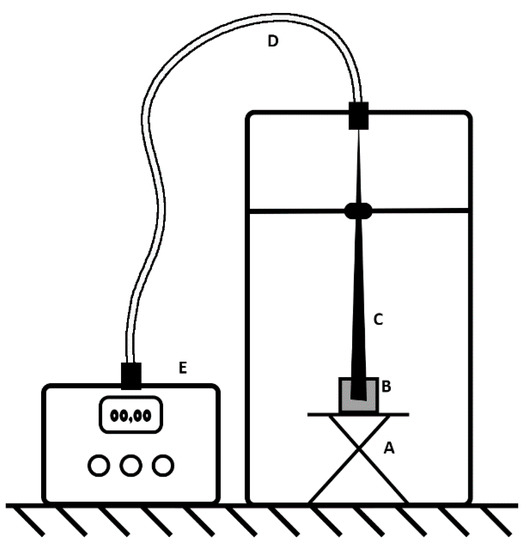
Figure 3.
Experimental set-up for monitoring bioluminescence from P. putida TVA8 and E. coli 652T7 bioreporters adhered to surface modified OFEs. All experiments were performed in a light-tight box that contained an adjustable stand (A), the induction solution (B), the OFE (C), and a light guiding cable (D) that terminated to a photon multiplier measurement device (E).
2.6. Visualization of OFE Cell Adherence Using Scanning Electron Microscopy (SEM)
SEM was used to verify the attachment of P. putida TVA8 to its APTES modified OFE. Since the OFEs themselves could not be processed for SEM imaging, quartz cones were used as an alternative (Figure S2). Quartz cones were surface modified with APTES and P. putida TVA8 cells were immobilized as explained above. Surface modified quartz cones with adhered cells were placed in a 50 mL beaker containing 30 mL of toluene induction solution. Bioluminescent signaling by the cells was verified by taking light measurements in a Perkin-Elmer IVIS Lumina K imaging system. After two days of immersion, SEM imaging was performed. The quartz cones with immobilized cells were fixed in McDowell–Trump Fixative (Fischer Scientific), gold coated (SPI Module Sputter Coater), and then viewed in a Zeiss Auriga SEM.
2.7. Statistics
Five different OFEs were tested (Figure 2). Five OFEs were modified with APES and one was modified with PEI. Each OFE was used once in a single experiment, which lasted 20 days, where light readings were taken every 30–60 min for 18 h. Replication of the immobilization technique on APTES modified quarz surface, and measurement of bioluminescence was shown. Data from the five OFEs plus one OFE from reference [19] were combined. Bioluminescence maxima, peak integrals, and times of the first bioluminescence maxima within the 20 days were plotted and approximated with polynomial and exponential curves respectively.
3. Results and Discussion
3.1. Imobilization and Induction of Bioluminescence from P. putida TVA8 on APTES Modified OFEs
The APTES modification of OFE led to the successful adherence of P. putida TVA8 on its surface. Two days after beginning the immobilization procedure, lumps of cell clusters (100–1000 µm apart) among much smaller scattered clusters or single cells were observed under SEM (Figure 4), which corresponds to standard biofilm establishment characteristics [27]. A fully developed biofilm layer of P. putida TVA8 was photographed after 130 days on APTES modified quartz fiber and was presented in a previous paper [19].
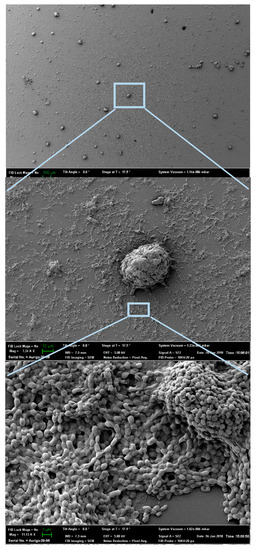
Figure 4.
Scanning Electron Microscopy (SEM) image of P. putida TVA8 on the (3-aminopropyl) (APTES) modified OFE after the second day of adsorption.
The time-records of daily inductions of the five different OFEs are shown in Figure 5.
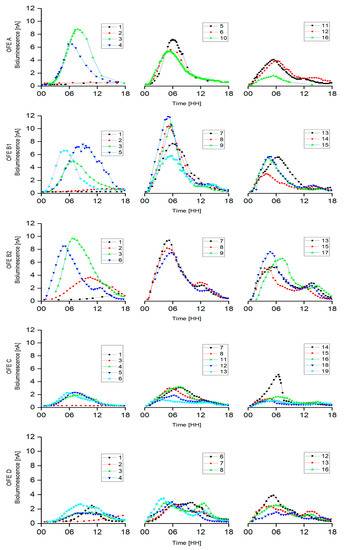
Figure 5.
Time-records of daily inductions of bioluminescence of P. putida TVA8 immobilized on each of the five available OFEs (A, B1, B2, C, D). Background noise of 26 nA was subtracted from the measured data. Y-axis denotes detected bioluminescence intensity in nA. X-axis denotes time from the induction of bioluminescence in hours. Each experiment lasted 15–19 days. Chart legends denote the measurement day number.
The intensities of the detected light were low during the first few days after induction and then gradually increased (Figure 6). This might be ascribed to an advanced covering of the base of the OFE with cells. Most time-record curves show two peaks.
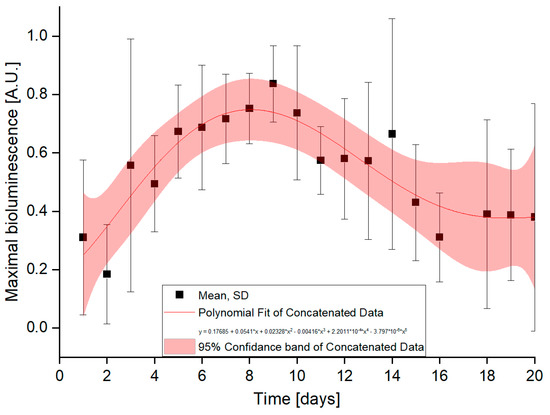
Figure 6.
Daily bioluminescence maxima normalized to 1. Aggregated data from the five OFEs plus one OFE from reference [19].
The times of the first bioluminescence maxima decreased from more than 10 h to 2–5 h after the fifth day of induction. The same times of the first maxima were observed in a previous study (Figure 7) [19]. The second bioluminescence maxima (appearing after 12–14 h) were probably caused by the bioluminescence of cells growing in the induction solution, which supports the video record (Video S1). This accelerated video shows the course of the induction of P. putida TVA8 adhered on the OFE cone. A gradual increase in bioluminescence of cells adhering on the APTES modified surface, the base, and the part of the cone, was followed by a high bioluminescence intensity located only on the base. The bioluminescence of these attached cells fell below the detection limits and at the end (12–15 h) a low light signal emerged in the induction solution.
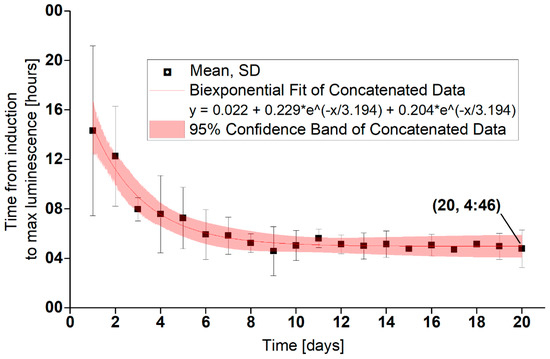
Figure 7.
Time of the first bioluminescence maxima. Aggregated data from the five OFEs plus one OFE from reference [19].
The measured intensities of bioluminescence significantly differed among the five OFEs. Table S1 compares time-records, bioluminescence maxima, and integrals of bioluminescence. OFEs were repeatedly induced over 20 days and bioluminescence always increased after immersion in the toluene induction solution (A 10x, B1 14x, B2 16x, C 15x, D 14x). To use such an OFE biosensor for the detection of toluene, a signal above twice the background noise of the detector (2 × 0.26 nA at 850 V) can reliably confirm the presence of toluene in the liquid sample. This level of bioluminescence generation appeared within 0.5 h after immersion in the induction solution. This growth was observed in all inductions (for all OFEs) with exceptions over the first two days. During this initial period, the cell layers were likely not matured and performed slowly, with low bioluminescent responses.
These results confirmed previous observations that OFEs adhering with P. putida TVA8 can be repeatedly used as a detector for toluene after a few days of the stabilization of immobilized cells [19]. A stabilization period of two to four days was observed, even if the cells were immobilized in silica gel [18,28]. Possible ways to improve the stability of bioluminescence signal responses include engineering a cell strain with two reporter genes (one under control of an analyte of interest and one constitutively present to monitor cell viability). An alternative to this is the use of two independent bioreporters (constitutive and inducible) derived from the same strain. Nevertheless, in the optical fiber arrangement, this resolution requires two fibers, which complicates the sensor construction. The analyte-specific signal must be than corrected according to cell viability [29]; or genetical manipulation of a bacterial strains ability to create and dissolve biofilm structure [30,31].
3.2. Influence of the Shape of OFE
The calculated characteristics of OFEs are presented in Table 2. Transmittances were calculated numerically as a percentage of rays that pass through the OFE from the wider end to a detector, which is placed on the thin end of the OFE. The number of cells on the wider end of each OFE was determined based on the assumption that the cells are spheres, with diameters of 1 µm, organized in one layer [17]. A product of transmittance and number of cells, referred to as OFE efficiency, is the relative amount of light transmitted by the OFE from a monolayer of cells on the wider end to the detector connected to the OFE thin end [32].

Table 2.
Calculated transmittance, cell number and efficiency of the five OFEs used in this study.
Using the same mathematical model Kalabova et al. [17], we predicted an outcome of experiments with an OFE and a plastic-clad-silica (PCS) fiber, in this study transmittances calculated among the five different OFEs differed by 3.6% at most (see Table 2). These transmittances are negligible in comparison to the changes in bioluminescence production, likely due to a fluctuation in the number of immobilized cells and their physiological state. Intensities of measured bioluminescence (Figure 5) were independent of OFE transmittances and OFE efficiencies. Intensity of bioluminescence production is susceptible to small variations of temperature, pH, medium composition, bioavailability of inducer to each single cell, and many other factors that cannot be completely controlled and increase the higher variability of the bioluminescence. Calculated transmittances of OFEs significantly increased as their shape moved closer to a frustum cone (Figures S3 and S4). In reality, OFEs always exhibit such a curved shape.
3.3. Immobilization and Induction of Bioluminescence from E. coli 652T7
In the LBKan growth medium, E. coli 652T7 did not adhere on the APTES modified base of the OFEs regardless of the addition of ferric chloride which was added to theoretically enhance the adhesion of microorganisms by lowering the repulsion forces [26]. Cell attachment was observed only at the interface of growth medium and air (Figure 8). At this interface, photon-OFE binding efficiency is <1%, thus bioluminescence of these attached cells did not significantly contribute to detected light.
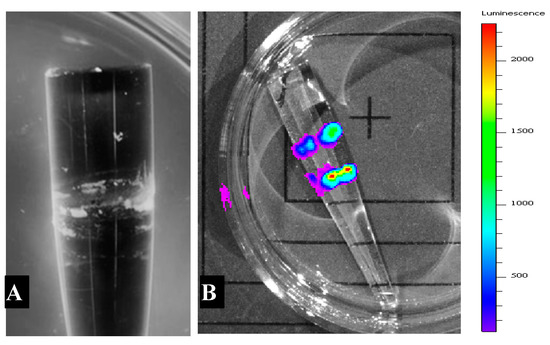
Figure 8.
(A) E. coli 652T7 on the surface of an APTES modified quartz cone after four days in Lauria-Bertani (LB)Kan cultivation medium. (B) Bioluminescence of E. coli 652T7 induced after immersion in LB medium as measured in an IVIS Lumina K imager (photons/sec/cm2/steradian)
E. coli 652T7 was immobilized on the base of OFE-D with PEI. The time records of daily inductions with LB medium is presented in Figure 9. Other than the first induction intensities, bioluminescence increased within 15 min after immersing the OFE into the LB solution. The intensities remained stable for 18 h on the first day, 6–9 h on all other days, and then sharply decreased due to a depletion of nutrients. To test the OFE with immobilized E. coli 652T7 as a biosensor for biotoxicity, HCl was added to the induction solution on the eighth day. This caused pH lowering to pH = 6 and decreased the bioluminescence, which did not recover after the following two inductions. These results imply that an OFE immobilized with E. coli 652T7 is sensitive to influences that affect cell viability but cannot be repetitively used as a biosensor since the cells are dying and not recovering.
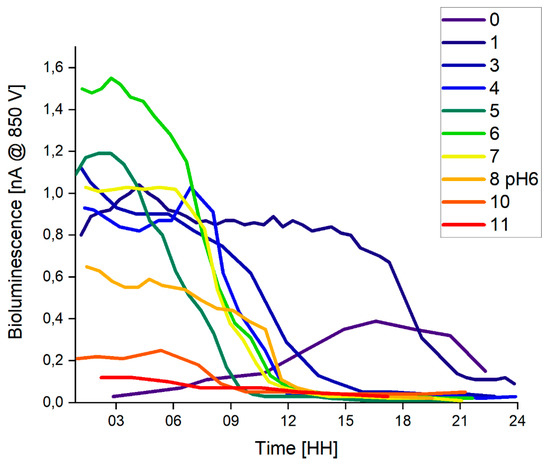
Figure 9.
Time records of bioluminescence of E. coli 652T7 immobilized on OFE D in polyethyleneimine (PEI). Legend denotes the days after the immobilization.
4. Conclusions
In this study, we immobilized the bioluminescent bioreporter P. putida TVA8 on a tapered OFE in order to prepare a biosensor for the detection of liquid toluene. This study broadened our previous research, where we used physico-chemical models, using contact angles and zeta potential, to facilitate the attachment of P. putida TVA8 to quartz surfaces after treatment with APTES. The biofilm development of P. putida TVA8 with time was quantified and the repeatability of the biofilm preparation and the repeatability of bioluminescence detection was determined. Other than a short maturation period (~5 days), the OFEs exhibited a stable bioluminescent response for at least 20 days.
We additionally immobilized the constitutively bioluminescent toxicity bioreporter E. coli 652T7 on a PEI modified OFE and demonstrated its potential use as a biosensor for cytotoxicity. Additionally, the immobilization process that we used, without any bulky matrix requirements, could be applied towards many other microbial bioreporters for the biosensing of a variety of different analytes. However, since the reproducibility of the bioreporter responses remains low, the developed biosensor can be used for online, rapid and multiplexed monitoring of the presence of a pollutant, but not its concentration.
Supplementary Materials
The following are available online at https://www.mdpi.com/1424-8220/20/11/3237/s1. Figure S1: Scheme of OFEs preparation with description; Figure S2: Quartz cones; Video S1: Video record of bioluminescence of Pseudomonas putida TVA8 attached on quartz cone. Video recorded for 17 h and accelerated to 20 s; Table S1: Integrals of intensities and maxima of bioluminescence for five OFEs; Figure S3: Plotted geometrical shape of five theoretical OFEs with identical Dmax, Dmin, (radius r) and length L, but different shape (bent), OFE models were used to calculate their transmittances; Figure S4: Calculated transmittances of the five theoretical OFEs based on their geometrical shapes.
Author Contributions
Conceptualization, J.Z., M.P. and S.R.; methodology, J.Z., S.R.; validation, J.Z., G.K. and S.R.; formal analysis, J.Z., J.T., M.P., G.K.; investigation, J.Z.; resources, J.Z., S.R.; data curation, J.Z. and G.K..; writing—original draft preparation, J.Z.; writing—review and editing, G.K., J.T. and S.R.; visualization, J.Z..; supervision, S.R. and M.P.; funding acquisition, J.Z. and J.T. All authors have read and agreed to the published version of the manuscript.
Funding
This research was funded by the internal Student Grant Competition of the Czech Technical University in Prague, CZ, grant numbers SGS17/110/OHK4/1T/17 and SGS18/097/OHK4/1T/17 and by Ministry of Education, Youth and Sports of the Czech Republic via project Smart City–Smart Region–Smart Community, grant number CZ.02.1.01/0.0/0.0/17_048/0007435.
Acknowledgments
Workplace, material support, and microorganisms were kindly provided by the University of Tennessee, Knoxville, TN, USA.
Conflicts of Interest
The authors declare no conflict of interest.
References
- Jones, O.; Preston, M.R.; Fawell, J.; Mayes, W.; Cartmell, E.; Pollard, S.; Harrison, R.M.; Mackenzie, A.R.; Williams, M.; Maynard, R.; et al. Pollution: Causes, Effects and Control; Royal Society of Chemistry: London, UK, 2015. [Google Scholar]
- Hill, M.K. Understanding Environmental Pollution; Cambridge University Press: Cambridge, UK, 2010. [Google Scholar]
- Mitra, S.; Roy, P. BTEX: A Serious Ground-water Contaminant. Res. J. Environ. Sci. 2011, 5, 394–398. [Google Scholar] [CrossRef][Green Version]
- Aksoy, M. Benzene and Leukemia. Environ. Health Perspect. 1991, 91, 165. [Google Scholar] [CrossRef] [PubMed]
- Lynge, E.; Andersen, A.; Nilsson, R.; Barlow, L.; Pukkala, E.; Nordlinder, R.; Boffetta, P.; Grandjean, P.; Heikkiia, P.; Horte, L.-G.; et al. Risk of cancer and exposure to gasoline vapors. Am. J. Epidemiol. 1997, 145, 449–458. [Google Scholar] [CrossRef] [PubMed]
- Lim, S.K.; Shin, H.S.; Yoon, K.S.; Kwack, S.J.; Um, Y.M.; Hyeon, J.H.; Kwak, H.M.; Kim, J.Y.; Kim, T.H.; Kim, Y.J.; et al. Risk assessment of volatile organic compounds benzene, toluene, ethylbenzene, and xylene (BTEX) in consumer products. J. Toxicol. Environ. Heal. Part A 2014, 77, 1502–1521. [Google Scholar] [CrossRef]
- Lu, Y.; Macias, D.; Dean, Z.S.; Kreger, N.R.; Wong, P.K. A UAV-Mounted Whole Cell Biosensor System for Environmental Monitoring Applications. In Proceedings of the IEEE Transactions on Nanobioscience, Quebec, QC, Canada, 12 November 2015; pp. 811–817. [Google Scholar]
- Nivens, D.E.; McKnight, T.E.; Moser, S.A.; Osbourn, S.J.; Simpson, M.L.; Sayler, G.S. Bioluminescent bioreporter integrated circuits: Potentially small, rugged and inexpensive whole-cell biosensors for remote environmental monitoring. J. Appl. Microbiol. 2004, 96, 33–46. [Google Scholar] [CrossRef]
- Heitzer, A.; Webb, O.F.; Thonnard, J.E.; Sayler, G.S. Specific and quantitative assessment of naphthalene and salicylate bioavailability by using a bioluminescent catabolic reporter bacterium. Appl. Environ. Microbiol. 1992, 58, 1839–1846. [Google Scholar] [CrossRef]
- Diplock, E.E.; Alhadrami, H.A.; Paton, G.I. Commercial Application of Bioluminescence Full Cell Bioreporters for Environmental Diagnostics. In Handbook of Hydrocarbon and Lipid Microbiology; Springer: Berlin, Heidelberg, 2010; pp. 4445–4458. [Google Scholar]
- Close, D.M.; Ripp, S.; Sayler, G.S. Reporter Proteins in Whole-Cell Optical Bioreporter Detection Systems, Biosensor Integrations, and Biosensing Applications. Sensors 2009, 9, 9147–9174. [Google Scholar] [CrossRef]
- Gutiérrez, J.C.; Amaro, F.; Martín-González, A. Heavy metal whole-cell biosensors using eukaryotic microorganisms: An updated critical review. Front. Microbiol. 2015, 6. [Google Scholar] [CrossRef]
- Kim, H.; Jung, Y.; Doh, I.J.; Lozano-Mahecha, R.A.; Applegate, B.; Bae, E. Smartphone-based low light detection for bioluminescence application. Sci. Rep. 2017, 7, 40203. [Google Scholar] [CrossRef]
- Regional Environmental Center and Umweltbundesamt GmbH, Chemicals and GMO Legislation. Handbook on the Implementation of EC Environmental Legislation; European Union: Szentendre, Hungary, 2014; Section 8; pp. 93–126. [Google Scholar]
- Lobsiger, N.; Stark, W.J. Strategies of immobilizing cells in whole-cell microbial biosensor devices targeted for analytical field applications. Anal. Sci. 2019, 35, 839–847. [Google Scholar] [CrossRef]
- Polyak, B.; Bassis, E.; Novodvorets, A.; Belkin, S.; Marks, R.S. Bioluminescent whole cell optical fiber sensor to genotoxicants: System optimization. Sens. Actuators B. Chem. 2001, 74, 18–26. [Google Scholar] [CrossRef]
- Kalabova, H.; Pospisilova, M.; Jirina, M.; Kuncova, G. Mathematical Model for Laboratory System of Bioluminescent Whole-Cell Biosensor with Optical Element. J. Biosens. Bioelectron. 2018, 9, 1–5. [Google Scholar]
- Kuncova, G.; Ishizaki, T.; Solovyev, A.; Trogl, J.; Ripp, S. The Repetitive Detection of Toluene with Bioluminescence Bioreporter Pseudomonas putida TVA8 Encapsulated in Silica Hydrogel on an Optical Fiber. Materials 2016, 9, 467. [Google Scholar] [CrossRef] [PubMed]
- Zajic, J.; Bittner, M.; Branyik, T.; Solovyev, A.; Sabata, S.; Kuncova, G.; Pospisilova, M. Repetitive inductions of bioluminescence of Pseudomonas putida TVA8 immobilised by adsorption on optical fiber. Chem. Pap. 2016, 70, 877–887. [Google Scholar] [CrossRef]
- Kuncova, G.; Pazlarova, J.; Hlavata, A.; Ripp, S.; Sayler, G.S. Bioluminescent bioreporter Pseudomonas putida TVA8 as a detector of water pollution. Operational conditions and selectivity of free cells sensor. Ecol. Indic. 2011, 11, 882–887. [Google Scholar] [CrossRef]
- Applegate, B.M.; Kehrmeyer, S.R.; Sayler, G.S. A chromosomally based tod-luxCDABE whole-cell reporter for benzene, toluene, ethybenzene, and xylene (BTEX) sensing. Appl. Environ. Microbiol. 1998, 64, 2730–2735. [Google Scholar] [CrossRef]
- Du, L.Y.; Arnholt, K.; Ripp, S.; Sayler, G.; Wang, S.Q.; Liang, C.H.; Wang, J.K.; Zhuang, J. Biological toxicity of cellulose nanocrystals (CNCs) against the luxCDABE-based bioluminescent bioreporter Escherichia coli 652T7. Ecotoxicology 2015, 24, 2049–2053. [Google Scholar] [CrossRef]
- Sanseverino, J.; Applegate, B.M.; King, J.M.H.; Sayler, G.S. Plasmid-mediated mineralization of naphthalene, phenanthrene, and anthracene. Appl. Environ. Microbiol. 1993, 59, 1931–1937. [Google Scholar] [CrossRef]
- Wang, J.; Du, S.; Onodera, T.; Yatabe, R.; Tanaka, M.; Okochi, M.; Toko, K. An SPR sensor chip based on peptide-modified single-walled carbon nanotubes with enhanced sensitivity and selectivity in the detection of 2,4,6-trinitrotoluene explosives. Sensors 2018, 18, 4461. [Google Scholar] [CrossRef]
- D’Souza, S.F.; Melo, J.S.; Deshpande, A.; Nadkarni, G.B. Immobilization of yeast cells by adhesion to glass surface using polyethylenimine. Biotechnol. Lett. 1986, 8, 643–648. [Google Scholar] [CrossRef]
- Fletcher, M. Attachment of Pseudomonas fluorescens to glass and influence of electrolytes on bacterium-substratum separation distance. J. Bacteriol. 1988, 170, 2027–2030. [Google Scholar] [CrossRef] [PubMed]
- Kokare, C.R.; Chakraborty, S.; Khopade, A.N.; Mahadik, K.R. Biofilm: Importance and applications. Indian. J. Biotechnol. 2009, 8, 159–168. [Google Scholar]
- Kuncova, G.; Pospisilova, M.; Solovyev, A. Optical Fiber Whole Cell Bioluminescent Sensor. In Proceedings of the XX International Conference on Bioencapsulation, Orillia, ON, Canada, 21–24 September 2012; B. Abstr. 2012, proceedings reference P_01. pp. 96–97. [Google Scholar]
- Roda, A.; Roda, B.; Cevenini, L.; Michelini, E.; Mezzanotte, L.; Reschiglian, P.; Hakkila, K.; Virta, M. Analytical strategies for improving the robustness and reproducibility of bioluminescent microbial bioreporters. Anal. Bioanal. Chem. 2011, 401, 201–211. [Google Scholar] [CrossRef]
- Angelaalincy, M.J.; Navanietha Krishnaraj, R.; Shakambari, G.; Ashokkumar, B.; Kathiresan, S.; Varalakshmi, P. Biofilm Engineering Approaches for Improving the Performance of Microbial Fuel Cells and Bioelectrochemical Systems. Front. Energy Res. 2018, 6. [Google Scholar] [CrossRef]
- Wei, Q.; Ma, L.Z. Biofilm matrix and its regulation in Pseudomonas aeruginosa. Int. J. Mol. Sci. 2013, 14, 20983–21005. [Google Scholar] [CrossRef]
- Pospisilova, M.; Kuncova, G.; Trogl, J. Fiber-Optic Chemical Sensors and Fiber-Optic Bio-Sensors. Sensors 2015, 15, 25208–25259. [Google Scholar] [CrossRef]
© 2020 by the authors. Licensee MDPI, Basel, Switzerland. This article is an open access article distributed under the terms and conditions of the Creative Commons Attribution (CC BY) license (http://creativecommons.org/licenses/by/4.0/).